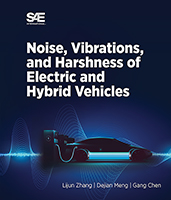Technical Paper
Active and Passive Control of Torsional Vibration in Vehicle Hybrid Powertrain System
2020-04-14
2020-01-0408
The vibration characteristics of hybrid vehicles are very different from that of traditional fuel vehicles. In this paper, the active and passive control schemes are used to inhibit the vibration issues in vehicle hybrid powertrain system. Firstly the torsional vibration mechanical model including engine, motor and planetary gear subsystems is established. Then the transient vibration responses of typical working condition are analyzed through power control strategy. Consequently the active and passive control of torsional vibration in hybrid powertrain system is proposed. The active control of the motor and generator torque is designed and the vehicle longitudinal vibration is reduced. The vibration of the planetary gear system is ameliorated with passive control method by adding torsional vibration absorbers to power units. The vibration characteristics in vehicle hybrid powertrain system are effectively improved through the active and passive control.

